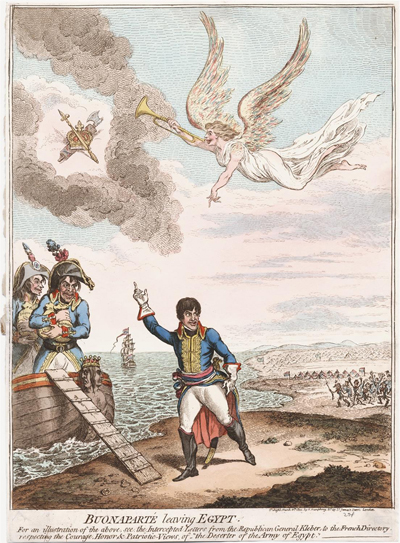Buonaparte Leaving Egypt
This is one of three prints in 1799/1800 featuring Napoleon Buonaparte, whose notoriety at that time was growing by leaps and bounds They include Exit Libertè a la Francois! or Buonaparte closing the Farce of Egalitè. . . (November 21, 1799) which portrays his role in the coup d'etat of November 9 and 10 thereby ending the rule of the French Directory; The French Consular-Triumverate (January 1, 1800), which portrays his heavy hand in the creation of the new French Constitution (December 24, 1799), that made him First Consul and effective ruler of France, and this print, Buonaparte Leaving Egypt (March 8, 1800).

© Lewis Walpole Library, Yale University
Oddly enough, the event it portrays—the departure of Buonaparte from Egypt after his defeat at St. Jean Acre—preceded those of the earlier prints, occurring in late August of 1799, and would seem to have been old news in March, 1800 when Gillray's print appeared. But the event was cast in a whole new light by the publication of the third volume of Copies of original letters from the army of General Bonaparte in Egypt which contained the Instructions from Buonaparte to General Kleber as he left Egypt and the dispatches from Kleber to the officials of the French Directory describing the perilous state of the troops Buonaparte had abandoned. That information only started to appear in summary or excerpts in mid-January. (See, for instance, the London Lloyd Evening-Post for January 17, 1800.)
The belated appearance of Gillray's print meant that Buonaparte Leaving Egypt could not only take advantage of the intercepted correspondence between Napoleon and Kleber and Kleber and the French Directorate, but also the reports of Buonaparte's subsequent behavior during the coup d'etat and the drafting of the new constitution.
From the intercepted correspondence Gillray would have learned that Napoleon's departure was a matter of both surprise and dismay to Kleber and the troops, that the troops were greatly diminished by plague and battle, that they were lacking even basic supplies, and that the Turks were closing in on them. All of this is suggested in his print by the pathetically small and emaciated group of tattered French soldiers who can be seen in the background, literally up in arms at Buonaparte's imminent departure, while a much larger Turkish camp looms behind. Gillray would also have learned that the army was left without a penny. Indeed the arrears of debt, reported by Kleber amounted to ten millions, four million of which was back-pay owed to the troops. This may have suggested to Gillray that Buonaparte and his entourage including "Generals Berthier, Lannes, Murat, Andreossi, and Marmont" must have made off with the funds, but so far as I can tell, that, at least, was false.
Central to the print is Napoleon's motive for leaving. In his letter to Kleber, Napoleon indicated that from the English newspapers he had
learnt that Italy was lost; that Turin, Tortona, and Mantua, were blockaded; but that if fortune favoured him, he should reach France by October, time enough to remedy the existing evils, and bring back the affairs of France from their present deplorable state, to the flourishing condition in which he had left them. He assures Kleber, that this consideration alone had determined him to quit the Army without further deliberation. (Evening Post Jan. 17, p2.)
Subsequent events in France, however, led Gillray to a different view. The military-assisted coup, the establishment of a Consular triumvirate where most of the power was concentrated in First Consul Buonaparte—both suggest the conclusion envisaged in the cloud above Naploeon's head where the revolutionary fasces is being visually crossed out and superceded by a crown and sceptre. As Gillray already suggested in The French Consular-Triumverate, here is a man whose constitutional aspirations included envisioning himself as a "Grande Monarche." The figure of Fame points derisively at Napoleon, but she is not using her trumpet, which may suggest that until the recent publication of the intercepted correspondence, Napoleon's fame did not really represent who he was or what he had done. In fact he had been greeted as a victorious hero when he returned to Paris.
The Janus faced image of Buonaparte on the prow of the boat provides a variant on the theme while suggesting his utter hypocrisy. It shows a benevolent face directed towards his troops—the image of a concerned general he tried to present in his letter to Keleber. But looking away from the troops is a second face, similar to the one on the central figure of Buonaparte—shifty, treacherous, and frowning— consistent with what Gillray ironically describes as "the Courage, Honor & Patriotic Views of 'the Deserter of the Army of Egypt.' But both faces are contained with a crown, suggesting that his future role as Monarch/Emperor was, in fact, part of his vision all along.
Sources and Reading
- Commentary from the British Museum on Buonaparte Leaving Egypt.
- Draper Hill, Mr. Gillray The Caricaturist, 1965, p. 126.
- "French campaign in Egypt and Syria," Wikipedia
- "Jean-Baptiste Kléber" Wikipedia
- "Napoleon," Wikipedia
- "Kléber Condemns Bonaparte in Letter to the Directory," Napoleon's Egypt
- Copies of original letters from the army of General Bonaparte in Egypt. . .
- "Fasces," Wikipedia
- "Crown Jewels of the United Kingdom," Wikipedia
- Thomas Wright and R.H. Evans, Historical and Descriptive Account of the Caricatures of James Gillray #254.
- Thomas Wright and Joseph Grego, The Works of James Gillray, the Caricaturist; With the History of His Life and Times, p. 261.
Comments & Corrections
NOTE: Comments and/or corrections are always appreciated. To make that easier, I have included a form below that you can use. I promise never to share any of the info provided without your express permission.